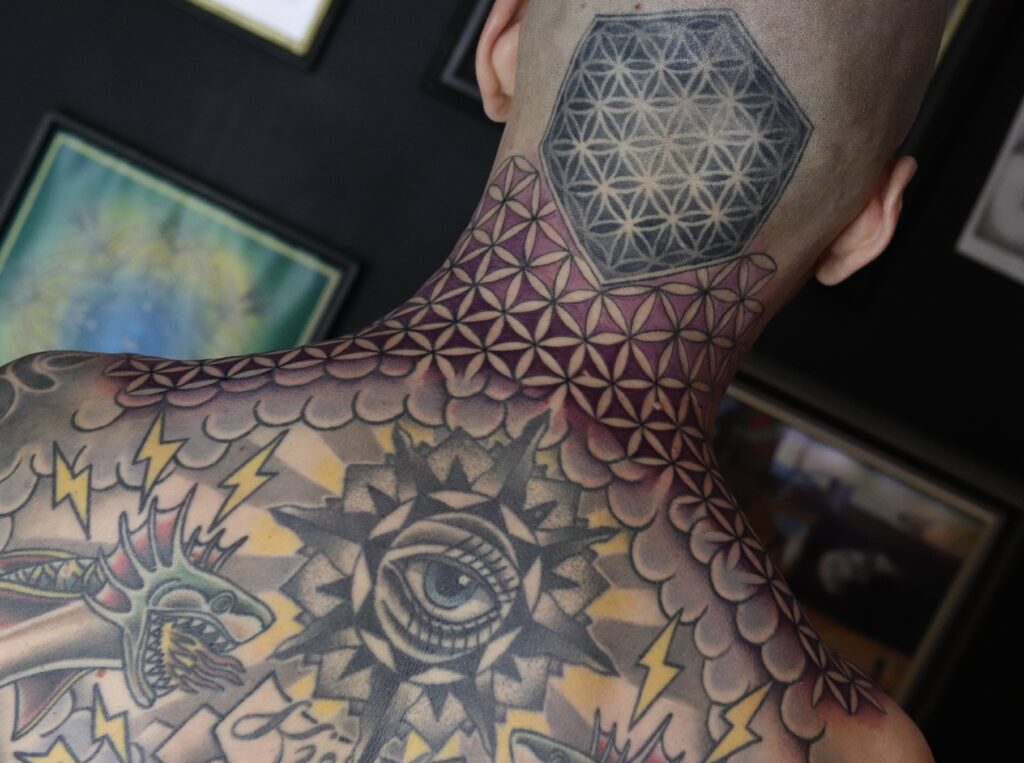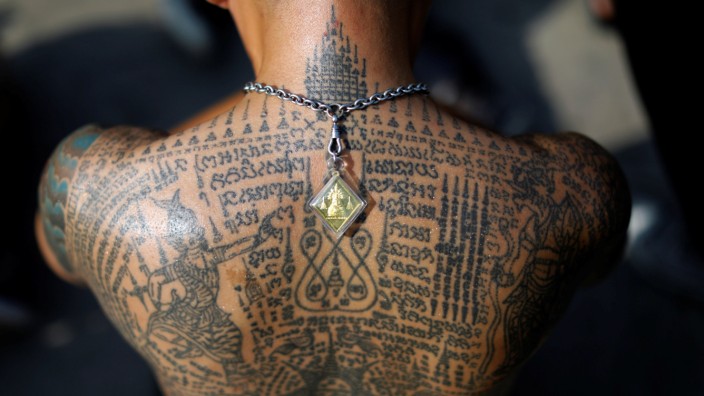
Tattooing is more than just art on skin; it can be a deeply spiritual practice and experience with a history that spans centuries and cultures. Let’s explore the spiritual history of tattooing, its significance in various belief systems, and the profound spiritual aspects that make it more than just body decoration.
I. Ancient Origins of Spiritual Tattooing:
Tattooing’s spiritual roots can be traced back to ancient civilizations worldwide. Tattoos were used as rites of passages, as a reflection of ones journey and the connection between body, mind and soul. Tattoos were commonly used as amulets and talismans, to bring protection, transformation, healing, empowerment, strenght, harmony or to deepen the connection to the divine.
Many cultures and civilizations throughout history have used ritual tattoos for various purposes. Here is a list of some cultures and civilizations known for their use of ritual tattoos:
- Polynesian Cultures: The Polynesian islands, including Samoa, Tahiti, Hawaii, and Maori culture in New Zealand, have a rich tradition of tattooing. These tattoos, such as the Maori moko and Samoan pe’a, were used to convey social status, tribal identity, and personal stories.
- Ancient Egypt: Tattoos were found on the mummies of ancient Egyptians, particularly on priestesses, indicating a connection to religious rituals and practices. These tattoos often featured symbols of protection and devotion.
- Ancient Japan: In Japan, tattoos known as irezumi or horimono have a long history. Samurai warriors often adorned their bodies with tattoos as a symbol of their bravery and loyalty. However, tattoos were also used to mark criminals.
- Native American Cultures: Various Native American tribes, such as the Sioux and Apache, used tattoos as a form of tribal identity and to symbolize achievements in battle or rites of passage.
- Celtic and Norse Cultures: The Celts and Norse peoples of Europe used tattoos to convey social status, tribal affiliation, and protective symbols. These tattoos often featured intricate knotwork and animal motifs.
- Pacific Islander Cultures: Apart from Polynesian cultures, other Pacific Islander cultures, like the Marquesas and Borneo tribes, also used tattoos as a form of tribal identification, protection, and beauty enhancement.
- Ainu Culture (Japan): The Ainu, an indigenous people of Japan, used tattoos, known as mouth tattoos, as a rite of passage for women. These tattoos had spiritual significance and denoted a woman’s maturity and ability to marry.
- Scythian Culture: The Scythians, a nomadic people from Eurasia, used tattoos to signify their tribal affiliations and rank within their society. These tattoos often featured animal motifs.
- Inuit Culture: Inuit women in the Arctic region had chin tattoos that were considered a rite of passage into womanhood and a symbol of maturity.
- Berber Culture: Some Berber tribes in North Africa used tattoos as a form of identification and protection, particularly among women. These tattoos often featured geometric designs.
- Borneo Tribes: The indigenous tribes of Borneo, such as the Iban and Dayak, have a rich tradition of tattooing. Tattoos were used to signify personal achievements, tribal identity, and protection from malevolent spirits.
- Southeast Asian Cultures: Various cultures in Southeast Asia, including the Khmer, Thai, and Burmese, have used tattoos for spiritual and protective purposes, often incorporating Buddhist or Hindu symbolism.
- Mesoamerican Civilizations: The Maya and Aztec civilizations in ancient Mesoamerica used tattoos to denote social status, religious significance, and tribal affiliations.
These are just a few examples, and many more cultures and civilizations have used tattoos as a means of expression, identity, and ritual throughout history. Tattooing has a rich and diverse global history, with each culture infusing its unique symbolism and significance into the practice.
With the rise of spirituality in our modern day society, the ritualistic aspect of tattooing is slowly making its way back into our world. Ritual tattoos in modern tattoo culture are a testament to the continued evolution of this ancient art form. While some people still draw inspiration from traditional rituals and cultural practices, others use tattooing as a means of exploring their own unique paths, stories, and transformations. The diversity and personalization of ritual tattoos in contemporary culture highlight the enduring power of tattooing as a form of self-expression and self-discovery. In modern-day tattoo culture, ritual tattoos have evolved to reflect contemporary beliefs, practices, and personal journeys. While traditional ritual tattoos were often deeply rooted in cultural or spiritual traditions, modern ritual tattoos are more individualized and may focus on personal transformation, self-expression, and symbolism.
II. Spiritual Significance in Tattoo Symbols:
Many symbols with profound spiritual meanings are commonly used in ritual tattoos to convey a sense of spirituality, inner growth, and personal transformation. Here are some of these symbols and their spiritual significance:
- Mandala: Mandalas are intricate geometric designs that symbolize unity, wholeness, and the universe. In Hinduism and Buddhism, mandalas represent the cosmos and are used as tools for meditation and spiritual transformation. Mandala tattoos often reflect an individual’s journey toward self-realization and inner peace.
- Lotus Flower: The lotus flower is a powerful symbol of purity and enlightenment in various spiritual traditions, particularly in Buddhism and Hinduism. Its growth from the muddy waters to the surface represents the journey from darkness to enlightenment. Lotus tattoos are chosen by those seeking spiritual awakening and personal growth.
- Yin and Yang: This ancient Chinese symbol represents the balance of opposing forces, such as light and dark, male and female, and good and evil. Yin and yang tattoos often signify the harmony and interconnectedness of these dualities in life.
- Om (Aum): The Om symbol is a sacred sound and spiritual icon in Hinduism, Buddhism, and Jainism. It represents the vibration of the universe and the unity of all things. Om tattoos are used to connect with higher consciousness and inner peace.
- Eye of Horus: Also known as the “All-Seeing Eye,” the Eye of Horus is an ancient Egyptian symbol of protection, healing, and enlightenment. It is often used to ward off negative energies and to promote spiritual insight and clarity.
- Hamsa Hand: The Hamsa Hand is a Middle Eastern amulet that symbolizes protection against the evil eye and negative energies. It is also seen as a symbol of blessing, power, and strength. Hamsa hand tattoos are chosen by those seeking protection and guidance on their spiritual path.
- Sri Yantra: The Sri Yantra is a complex geometric symbol originating from Hinduism and represents the union of the divine masculine and feminine energies. It is believed to bring harmony, abundance, and spiritual growth. Sri Yantra tattoos are popular among those seeking balance and prosperity.
- Tree of Life: This symbol is found in various cultures and religions, including Christianity, Buddhism, and Norse mythology. The Tree of Life represents the interconnectedness of all living beings, growth, and the cycle of life, death, and rebirth.
- Ankh: The Ankh is an ancient Egyptian symbol that signifies life, immortality, and regeneration. It is often associated with the god Osiris and is considered a powerful symbol of eternal life.
- Cross: The Christian cross is a universal symbol of faith and the sacrifice of Jesus Christ. It represents salvation, redemption, and the connection between humanity and the divine. Cross tattoos hold deep spiritual meaning for Christians.
- Hopi Maze: The Hopi Maze or Man in the Maze is a Native American symbol representing the journey of life. It depicts a person at the center of a maze, navigating the twists and turns of existence, seeking balance and fulfillment.
- Sacred Geometry: Various geometric shapes and patterns, such as the Flower of Life, Metatron’s Cube, and the Fibonacci spiral, are used in tattoos to explore the mathematical and spiritual order underlying the universe.
These symbols, whether from ancient traditions or modern interpretations, carry profound spiritual meanings and are chosen by individuals seeking to connect with deeper aspects of themselves, find guidance, or mark significant moments on their spiritual journeys. Tattooing these symbols is a way to carry their spiritual significance with them as a constant reminder of their beliefs and intentions.
III. Spiritual Transformation through Tattooing:
Tattooing can be a transformative and spiritual experience:
- Rite of Passage:
- For some, getting a tattoo marks a rite of passage or a significant life change. It symbolizes personal growth, transformation, and a deeper connection to one’s inner self.
- Healing and Closure:
- Tattoos can be a way to heal emotional wounds or find closure after difficult experiences. They serve as reminders of strength and resilience.
V. Tattoo Rituals and Blessings:
- In some cultures, tattoo rituals involve blessings from spiritual leaders or shamans. These blessings are believed to infuse the tattoo with protective and sacred energy.
Tattooing has a rich spiritual history that continues to evolve in contemporary culture. Beyond aesthetics, tattoos can serve as powerful symbols of spirituality, personal growth, and connection to the divine. Whether it’s a sacred symbol, a meaningful mantra, or a personal journey etched on the skin, spiritual tattoos are a testament to the enduring connection between body and soul, past and present, and the earthly and the divine.
In the next post we will explore how a tattoo ritual might look like .
R.

